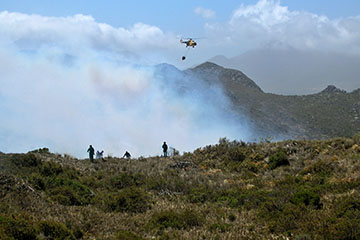Wildfire season
 During the hot and dry summer season, wildfires are more prevalent and are difficult to control. Wildfires (also referred to as veld fires) are bush fires both within and outside urban areas that have the potential to spread out of control. Most wildfires are started by people, compared to a small amount which is started by natural occurrences such as lightning.
During the hot and dry summer season, wildfires are more prevalent and are difficult to control. Wildfires (also referred to as veld fires) are bush fires both within and outside urban areas that have the potential to spread out of control. Most wildfires are started by people, compared to a small amount which is started by natural occurrences such as lightning.
Early fire warnings remain critical to controlling fires quickly. When a fire does break out, getting control over it as quickly as possible is vital. If a fire is contained within the first hour, the possibility of a major incident is minimised. The public is therefore implored to report any signs of fire, regardless of how insignificant it may appear, to their local fire service by dialing 112.
5 Main causes of wildfires are:
- Intentional: Arson is a malicious and criminal act of deliberately starting fires.
- Smoking: Discarded cigarette butts can also cause wildfires, either from workers working in the fields or bush, passing pedestrians or motorists.
- Cooking fires: Open fires for cooking and discarded hot ashes can cause wildfires, particularly in nature conservation areas or on farms.
- Burning of debris: Permitted and unpermitted burning of debris, if badly managed or if weather conditions change suddenly, can cause fires.
- Lightning: Lightning is a cause of both wildfires and structural fires.
Wildfires can spread rapidly under the following conditions:
- Faster uphill than downhill.
- With the wind, rather than against the wind.
- Faster where there is dry and dead plant material.
- Faster with small sources of fuel.
- Faster where the vegetation canopy is intertwined.
Although wildfires can have devastating effects on people’s lives, property and animals, they’re also important for local ecosystems. For example, the heat generated by fires, help certain types of fynbos plant seeds to germinate.
So, having a better understanding of wildfires can help you to be better prepared.
Fire danger rating
The Fire Danger Rating is determined by using a combination of the temperature, wind direction and speed; rainfall and humidity - which can be calculated manually or by using technology. The Fire Danger Rating Table is colour-coded, and this national system classifies the level of fire danger in 5 categories:
- Insignificant (blue). The fire danger is so low that no precautions are needed.
- Low (green). Fires, including prescribed burns, may be allowed in the open air on the condition that persons making fires take reasonable precautions against fires spreading.
- Moderate (yellow). No fires are allowed in the open air, except those that are authorised by the Chief Fire Officer of the local fire service, and those in designated fireplaces. Authorised fires may include prescribed burns.
- High (orange). No fires are allowed under any circumstances in the open air.
- Extreme (red). No fires are allowed under any circumstances in the open air, and special emergency fire preparedness measures are necessary
Video
Find out how you can get involved to help fight wildfires in the Western Cape.


